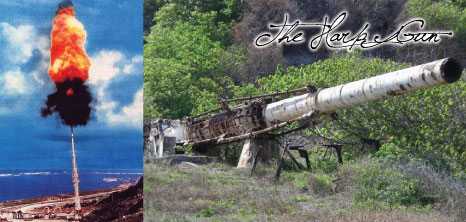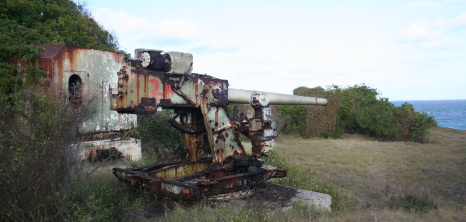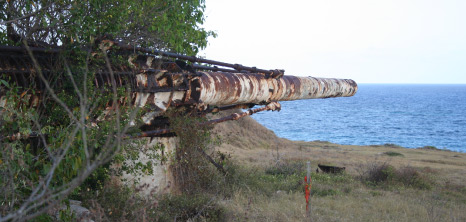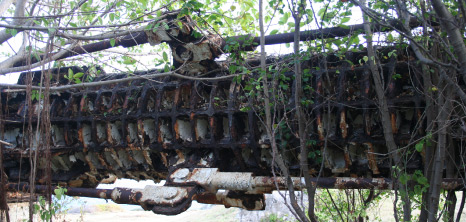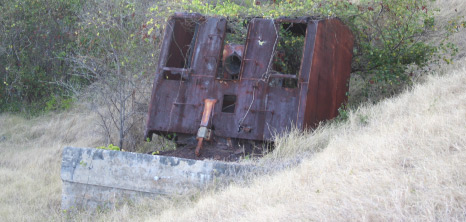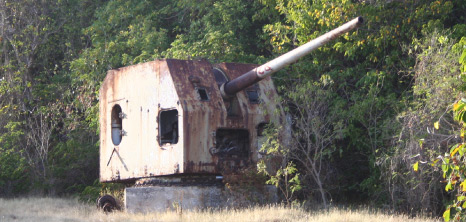|
High Altitude Research Project (Harp Gun)The paramount goal of the HARP (High Altitude Research Project) was the establishment of a satellite launcher. In the early 1960s, Donald Mordell had the view that the island of Barbados would have been the ideal place for such a project. Based on its geographical location at 13ºN, it was seen as an excellent site for satellite launches. Barbados' location also augured well for thousands of miles of downrange area over the Atlantic Ocean for the safe impact of projectiles.
McGill University had been operating a meteorological station in Barbados and as a result had developed close connections with the Democratic Labour Party (DLP). Gerald Bull met with the then Prime Minister Errol Barrow and arranged for a firing site in Foul Bay, St. Philip. The HARP in Barbados was acquired from the American arsenal and was the largest artillery piece to be sourced - a 16-inch battleship gun complete with a land mount and surplus powder charges. A heavy-duty crane moved the gun and a $750,000-dollar radar tracking system was contributed by the U.S. Army's Ballistic Research Laboratory (BRL).
This event stirred quite a bit of attention towards Barbados and the University of McGill as there was nowhere else in the world that such a massive gun based development program such as this was ever handed over to a private entity.
The Beginnings of the HARP ProjectBoth Mordel and Bull held a press conference in March of 1962 that heard the official announcement of the HARP project. In April, HARP began the process of installing the big 16-inch gun on the island of Barbados. By May of that same year, the gun pit was ready and the big 16-inch gun was on its way.
The guns arrived but could not be put ashore at the site due to the rough coastline and had to be offloaded 7 miles down the coast. They were then transported overland via a temporary purpose-built railway that employed hundreds of people from Barbados. As the project continued, the employment figures grew and so sparked further support from Barrow.
Nearing the summer period of 1962, the Barbados launch site was beginning to take the form of a somewhat modern-day space launch complex. The gun was completely set up and the other facilities were approaching the finalisation process as workshops, storage buildings, propellant magazines, telemetry and radar installations, and an abundance of other facilities were built.
With the big 16-inch gun launch site facilities in place, the true test of the HARP program was set to literally get off the ground. In January of 1963, the HARP gun fired its first test shot into the sky at an almost verticle angle. This created quite an historic event as it was the first time a gun of this capacity had been fired at such an angle. With a launch velocity of 1000 m/s and a flight time of approxmately 58 seconds, the wooden slug rose to an altitude of 3000 meters before coming down a kilometre off shore.
On 21 January the first Martlet 1 was launched. It flew for 145 seconds and achieved an altitude of 26 km. On 23 January a second test slug was flown. On 1 February a second Martlet 1 reached an altitude of 27 km. This was the first flight of a Martlet with a radio transmitter beacon that allowed the vehicle to be tracked throughout the flight. With these four successful flights the first test series ended.
The next series of test flights was conducted in early April using the new Martlet 2. The Martlet 2 vehicles performed well and upper atmospheric research with the 16-inch gun began. By the end of June a new world's gun-launched altitude record of 92 km had been set with a Martlet 2 by the big 16-inch gun located in Barbados.
1963 also saw the development of the first gun-launched rockets. The Martlet 3A program began in the spring of 1963. Test firings kicked off in September with launches proceeding to the end of the year.
By the middle of 1965, the HARP project was in full swing and the big 16-inch gun on Barbados soil was firing on a regular basis.
By the start of 1966, the HARP Program saw the rising up of ugly heads that were hard at work behind the scenes trying to wreck its progress. A bureaucratic strain on the program started to take a toll and relatively key staff were made redundant. This caused the operations in Barbados to go defunct.
During the time of the firings of the HARP gun, many houses and buildings in Barbados within close proximity developed cracks in various areas. It was noted that the vibrations were felt miles away and in some instances felt like earth tremors. The Government of Barbados at the time was not interested in honouring any such claims made by householders and so the project was not well-liked by the Barbadian population.
Remnants of the now defunct HARP Project can be still found at its current site.
Gerry Bull's AssasinationIn the mid-1980s, Bull entered into an agreement with the nation of Iraq to fabricate a satellite launching gun system. The Babylon Gun was a massive 1000 mm bore, 156 meter long, satellite launching gun. Despite the fact that based on its size, it was no real threat, it was still seen as such by Iraq's neighbours. Bull was earmarked for assassination after he refused to be persuaded by threats.
Bull met his untimely death on the evening of March 22, 1990, at the age of 62. As he approached his apartment door in Brussels, he was shot six times in the back of the head. Despite the assassin being reported to be Israeli military, the case was never solved.
His last Supergun was cut up and scrapped by the UN at the conclusion of the Iraq/Kuwait war and was never assembled or fired.
Further information on the HARP Project in Barbados can be sourced at the following website http://www.astronautix.com/articles/abroject.htm.
Images of Remnants of the Now Defunct HARP Project
|



